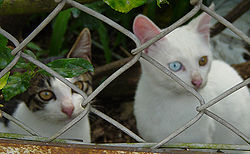AY Honors/Cats - Advanced/Answer Key
The Japanese Bobtail is a breed of cat with an unusual 'bobbed' tail more closely resembling the tail of a rabbit than that of an ordinary feline. The short tail is caused by the expression of a recessive gene. Thus, so long as both parents are bobtails, all kittens born to a litter will have bobtails as well. Unlike the Manx and other cat breeds, where genetic disorders are common to tailless or stumpy-tails, no such problem exists with the Japanese Bobtail.
The Japanese Bobtail is a small domestic cat native to Japan and Southeast Asia. The breed has been known in Japan for centuries, and there are many legends and myths, as well as pieces of ancient art, featuring it.
Japanese bobtails may have almost any color, but calico (called "Mi-ke", meaning "three-fur") or bi-colours are especially favoured by the Japanese.
History
The earliest written evidence of cats in Japan indicates that they arrived from China or Korea at least 1,000 years ago. In 1602, Japanese authorities decreed that all cats should be set free to help deal with rodents threatening the silk-worms. Buying or selling cats was illegal, and from then on, bobtailed cats lived on farms and in the streets. Japanese Bobtails thus became the "street cats" of Japan.
The Japanese Bobtail is mentioned in Kaempfer's Japan. First published in London in 1701/02, it is the first book written by a Westerner about the flora, fauna, and landscape of Japan. Engelbert Kaempfer, a German doctor, wrote: "there is only one breed of cat that is kept. It has large patches of yellow, black and white fur; its short tail looks like it has been bent and broken. It has no mind to hunt for rats and mice but just wants to be carried and stroked by women."Template:Fact
The maneki-neko ("beckoning cat"), a Japanese Bobtail seated with one paw raised, is considered a good-luck charm. A maneki-neko statue is often found in the front of stores. In 1968 the late Elizabeth Freret imported the first three Japanese Bobtails to the United States from Japan. In 2001 the first registered litter of Bobtails in the UK were bred under the "Solstans" prefix.
Legend
There is a legend in Japan about why the Japanese Bobtail lost its tail. It states that a cat was warming itself too close to a fire, and set its tail on fire. It then ran through the town, burning many buildings to the ground. As punishment, the Emperor decreed that all cats should have their tails cut off.
Breed Standard
Head: The head should form an equilateral triangle. (Not including ears)
Ears: Large, upright, set wide apart but at right angles to the head and looking as if alert.
Muzzle: Fairly broad and round neither pointed nor blunt.
Eyes: Large, oval rather than round. They should not bulge out beyond the cheekbone or the forehead.
Body: Medium in size, males larger than females. Long torso, lean and elegant, showing well developed muscular strength. Also balance is very very important.
Neck: Not too long and not too short, in proportion to the length of the body.
Legs: Long, slender, and high. The hind legs longer than the forelegs.
Paws: Oval. Toes: five in front and four behind.
Coat (Shorthair): Medium length, soft and silk.
Coat (Longhair): Length medium-long to long, texture soft and silky gradually lengthening toward the rump.
Tail: The tail must be clearly visible and is made up of one or more curves.
The Japanese Bobtail is a recognised breed by all major registering bodies: CFA ([1]), TICA ([2]), FIFe; Shorthair only ([3]) with the exception of GCCF (UK).
General
Japanese Bobtails usually have litters of three to four kittens with newborns that are unusually large compared to other breeds. They are active earlier, and walk earlier. Affectionate and generally sweet-tempered, they enjoy supervising household chores and baby-sitting. They are active, intelligent, talkative cats with a well-defined sense of family life. Their soft voices are capable of nearly a whole scale of tones; some people say they sing. Since they adore human companionship they almost always speak when spoken to. Because of their human-oriented personality they are easy to teach tricks and enjoy learning things like walking on a harness and lead.
Ocular Heterochromia
While rare, Japanese Bobtails, especially predominantly white specimens, are more likely than other breeds to express heterochromia, or differing iris colors. One eye will be blue while the other is yellow (though in Japan, blue is referred to as silver while yellow is referred to as gold). This trait is popular and kittens displaying this "odd-eye" feature are usually more expensive.
External links
fr:Bobtail japonais nl:Japanse stompstaartkat ja:ジャパニーズボブテイル fi:Japanin bobtail


